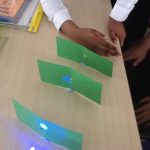The Importance of Science
“Science stimulates and excites pupils’ curiosity about phenomena and events in the world around them. It also satisfies this curiosity with knowledge. Because Science links direct practical experience with ideas, it can engage learners at many levels. Scientific method is about developing and evaluating explanations through experimental evidence and modelling. This is a spur to critical and creative thought.”
Through providing appropriate and stimulating scientific experiences we encourage pupils to make sense of the world around them. Pupils work together to observe, explore and ask questions. They collect evidence to help them answer questions and link this to scientific ideas. Pupils evaluate evidence and consider whether tests or comparisons are fair. They use reference materials to find out more about scientific ideas. Pupils share their ideas and communicate them using scientific language, drawings, charts and tables and graphs. They apply their knowledge and understanding of scientific ideas to familiar phenomena, everyday things and their personal health.
“Science is a way of thinking about our world that can lead to changing it for the better.”
Working Scientifically
Working Scientifically although described separately below, is not taught as an individual strand. It is the driving force of lessons and is embedded within lessons.
Children will learn a variety of approaches to answer scientific questions.
Enquiry strategies include:
Observing over time- when children observe or measure how one variable changes over time.
Identifying and classifying- when children identify and name materials and living things and make observations to carry out tests to organise them into groups.
Looking at patterns- when children make observations or carry out surveys of variables that cannot be easily controlled and look for relationships between two sets of data.
Comparative and fair testing- when children observe or measure the effect of changing one variable when controlling others as far as possible.
Answering questions and using secondary sources of evidence- when children answer questions using data or information that they have not collected first hand.
EYFS
Young children have an energy and enthusiasm that can enable them to be amazing explorers of their world (Primary Science Teaching Trust).
Within the Early Years Framework, children at the expected level of development will be able to do the following:
- Explore the natural world around them, making observations and drawing pictures of animals and plants;
- Know some similarities and differences between the natural world around them and contrasting environments, drawing on their experiences and what has been read in class;
- Understand some important processes and changes in the natural world around them, including the seasons and changing states of matter.
We are very much led by the children and encourage, draw out and build on their innate curiosity.
There is much evidence showing that children’s interest in science is shaped before they leave primary school. So there is a very pressing need to ensure that primary-aged children do not lose that latent interest and enthusiasm for the world around them, and the science that underpins this (PSTT).
We also sometimes use the PSTT’s provision maps which are not a scheme but give a flexible starting point for talking about science with very young children. They are adapted to the needs and abilities of Oak View’s children and our school. Some of these maps are linked to common topics and others are linked to storybooks or nursery rhymes.
Finally, we use the PLAN Assessment resources particularly for working scientifically skills and undertaking enquiries that will allow the children to make effective progress into Key Stage 1.
Key Stage 1
During years 1 and 2, pupils will be taught to use the following practical scientific methods, processes and skills through the teaching of the programme of study content:
- asking simple questions and recognising that they can be answered in different ways
- observing closely, using simple equipment
- performing simple tests
- identifying and classifying
- using their observations and ideas to suggest answers to questions
- gathering and recording data to help in answering questions.
Key Stage 2 (Lower key stage)
During years 3 and 4, pupils will be taught to use the following practical scientific methods, processes and skills through the teaching of the programme of study content:
- asking relevant questions and using different types of scientific enquiries to answer them
- setting up simple practical enquiries, comparative and fair tests
- making systematic and careful observations and, where appropriate, taking accurate measurements using standard units, using a range of equipment, including thermometers and data loggers
- gathering, recording, classifying and presenting data in a variety of ways to help in answering questions
- recording findings using simple scientific language, drawings, labelled diagrams, keys, bar charts, and tables
- reporting on findings from enquiries, including oral and written explanations, displays or presentations of results and conclusions
- using results to draw simple conclusions, make predictions for new values, suggest improvements and raise further questions
- identifying differences, similarities or changes related to simple scientific ideas and processes
- using straightforward scientific evidence to answer questions or to support their findings.
Key stage 2 (Upper key stage)
During years 5 and 6, pupils will be taught to use the following practical scientific methods, processes and skills through the teaching of the programme of study content:
- planning different types of scientific enquiries to answer questions, including recognising and controlling variables where necessary
- taking measurements, using a range of scientific equipment, with increasing accuracy and precision, taking repeat readings when appropriate
- recording data and results of increasing complexity using scientific diagrams and labels, classification keys, tables, scatter graphs, bar and line graphs
- using test results to make predictions to set up further comparative and fair tests
- reporting and presenting findings from enquiries, including conclusions, causal relationships and explanations of and degree of trust in results, in oral and written forms such as displays and other presentations
- identifying scientific evidence that has been used to support or refute ideas or arguments.



